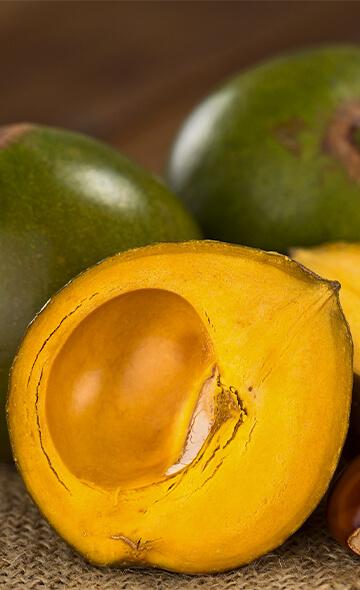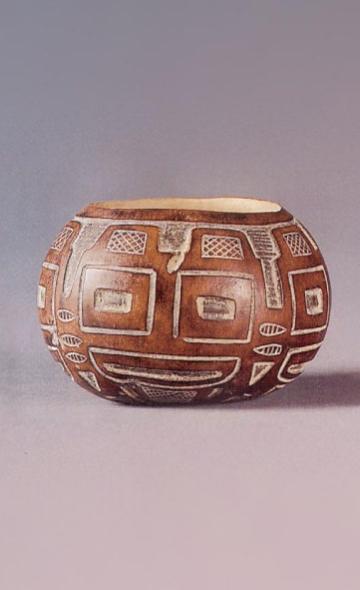- Visitors
- Researchers
- Students
- Community
- Information for the tourist
- Hours and fees
- How to get?
- Virtual tours
- Classic route
- Mystical route
- Specialized route
- Site museum
- Know the town
- Cultural Spaces
- Cao Museum
- Huaca Cao Viejo
- Huaca Prieta
- Huaca Cortada
- Ceremonial Well
- Walls
- Play at home
- Puzzle
- Trivia
- Memorize
- Crosswords
- Alphabet soup
- Crafts
- Pac-Man Moche
- Workshops and Inventory
- Micro-workshops
- Collections inventory
- News
- Researchers
- Series on Andean Food: Lúcuma
News
CategoriesSelect the category you want to see:

International academic cooperation between the Wiese Foundation and Universidad Federal de Mato Grosso do Sul ...

Clothing at El Brujo: footwear ...
To receive new news.
Por: Jose Ismael Alva Ch. y Leslie Zuñiga Becerra
By Jose Ismael Alva Ch. And Leslie Zuñiga Becerra
Lúcuma (Pouteria lucuma) is the native fruit of the Andes. It is there where the earliest evidence of its consumption and domestication is found. The soft yellow layer of this fruit is commonly eaten fresh and has a pleasant flavor. Let's review now some insights about its history, its consumption as food, as well as its nutritional and medicinal properties.
Historical notes
Lúcuma is one of the fruits that Europeans discovered when they arrived in the Andes. According to Father Bernabé Cobo, lucma was the way the natives called this fruit. Later, in their continued pronunciation, the Spanish added the "u", thus giving it its current name [1]. Apparently, not only the yellow content of lúcuma was used by the ancient Andeans. According to Cobo, eventually the hard shell of the seed was removed in order to eat the kernel after roasting it, though its flavor would become bland [1].
The antiquity of lúcuma
The Guitarrero cave, located in the Callejón de Huaylas (Ancash highlands), has the earliest evidence of lúcuma consumption. In the times of hunters and gatherers, the ancient people who occupied Guitarrero in 8 500 BC, collected, among other wild species, the lúcuma from their surroundings [2].
Also, the Paredones sector, located in the southern part of the El Brujo Archaeological Complex, contains the oldest lúcuma remains on the coast. According to radiocarbon dating, the first consumptions of this fruit date back to 5 500 [3]. Since then, the lúcuma appears as one of the most consumed fruits throughout the pre-Hispanic periods.
The wood of the lucumo tree
The tree of this fruit, the lucumo, was highly esteemed by the Hispanics of the XVII century for its good appearance [1]. Likewise, lucumo wood was appreciated in carpentry for being fine and compact [4]. Thus, some evidence of its use can be observed in the carving of large objects during pre-Hispanic times in the El Brujo Archaeological Complex. The ancient Moche (100-800 AD) made a 2.5 m tall sculpture on lucumo wood, which was found in the Huaca Cao Viejo and is currently exhibited in the Cao Museum. The idol presents the figure of an anthropomorphic personage which features two lunar animals, fabulous beings in the iconographic narrative of the North Coast of Peru [5].
Lúcuma in Andean myths
It is usually related to the legend of Cahuillaca, a young maiden with a proud and contemptuous character, accustomed to rejecting all the men who courted her. One day, while she was resting in the shade of a lúcuma tree, Cuniraya Huiracocha, god of the field, took the form of a bird and dropped a fruit from the tree, in which he had previously deposited his seed.
When Cahuillaca ate the fruit, she became pregnant. She conceived a boy who, after one year, began to take his first steps. Then, she decides to call the men to clarify who was the father of her son. The men gathered. Cahuillaca asked them to tell her who was the father and in the face of everyone's silence, she decided that the boy should identifies his progenitor. The boy, crawling, reached Cuniraya Huiracocha, who had taken the form of a dirty and ragged beggar, he stayed at his feet, hugged him and smiled very joyfully. The maiden felt ashamed for having had the son of a beggar and decided to run towards the beach with the boy in her arms. When they reached the shore, in front of Pachacamac, she threw herself into the sea. Then, she and her son turned into two islets that are very close to the shore [6]. The legend spread and the fruit was marked with the unique myth of getting pregnant by eating the fruit that contains the "love" of a god.
Lúcuma production in Contemporary Peru
Currently, the regions of Peru that produce lúcuma are Ayacucho, Ancash, Arequipa, Cajamarca, Huánuco, Moquegua, Piura and Lima. In 2019, the countries with the highest demand for this fruit were the Netherlands, Russia, the United States, the United Kingdom, Canada and Hong Kong [7].
As sweet as love
This fruit has a creamy and velvety texture. Its aroma is pleasant and its flavor is peculiar and exotic. It is used as a natural sweetener because the sugar content in the fruit is medium-high and its sweetness is intense. For this reason, in Peru it is used mainly for the production of ice creams, desserts and, secondarily, for yogurts, bakery products and pastries, in its presentation as fresh pulp, flour or as a complement in meals [8].
Among the desserts that stand out are the Suspiro limeño de lúcuma, crunchy lúcuma, lúcuma mousse, lúcuma cheesecake and lúcuma ice cream, among others.
A valuable fruit for health
Lúcuma has extraordinary medicinal properties, such as protecting the skin (it contains beta-carotene, an antioxidant that reduces damage caused by UV rays), it keeps the nervous system functions normal (vitamin B3 prevents nervous and mental disorders) and boosts the immune system (beta-carotene strengthens defenses) [9]. In addition, the gallic acid (antioxidant) present in the fruit is related to anti-inflammatory, antibiotic, cardiovascular protection, anti-cancer and antioxidant activity [8].
It has components that restrict the elevation of glucose in the blood, thus preventing diabetes. It also acts as an antihypertensive, as it has phenolic components that manage to inhibit the angiotensin-converting enzyme, fighting against high blood pressure, preventing heart disease and showing that it is an alternative to drugs with the same purpose [8].
Bibliography
[1] Cobo, B. 1964 [1653]. History of the New World. First part. Library of Spanish Authors Volume XCI. Madrid: Atlas editions.
[2] Lumbreras, L. 2008. The origins of Andean society. Compendium of Economic History of Peru. Volume 1: Pre-Hispanic Economy. C. Contreras (Ed.), Pp. 23-135. Lima: Banco Central de Reserva del Perú – Institute of Peruvian Studies.
[3] Bonavia, D., V. Vásquez, T. Rosales, T, Dillehay, P. Netherly, P. and K. Benson. 2017. Plant Remains. Where the Land Meet the Sea. Fourteen Millennia of Human History at Huaca Prieta, Peru. T. Dillehay (Ed.), Pp. 367-433. Austin: University of Texas.
[4] Fernández, A and E. Rodríguez. 2007. Ethnobotany of Pre-Hispanic Peru. Trujillo: Herbarium Truxillense.
[5] Franco, R. and Gálvez, C. 2003. A wooden idol in an early Mochica edifice at Huaca Cao Viejo, El Brujo Complex. Arkinka, 93, pp. 94-105.
[6] Tavera, V., L (s.f.). The Myth of Cuniraya Huiracocha. Archeology of Peru. https://www.arqueologiadelperu.com.ar/cuniraya.htm
[7] Andina. (January 9, 2019). Lúcuma: these are the regions that produce this superfood that seduces the world. https://andina.pe/agencia/noticia-lucuma-estas-son-las-regiones-productoras-este-superalimento-seduce-al-mundo-780895.aspx
[8] Maza-De la Quintana, R., & Paucar-Menacho, L. (2020). Lúcuma (Pouteria lucuma): Composition, bioactive components, antioxidant activity, uses and beneficial properties for health. Scientia Agropecuaria, 11 (1), 135-142.
[9] Peru21 (November 8, 2017). Learn about 7 benefits of consuming a delicious lúcuma [Press release]. https://peru21.pe/fotogalerias/conoce-7-beneficios-consumir-deliciosa-lucuma-fotos-383550-noticia/
[10] Reyes García, M., Gómez-Sánchez Prieto, I., & Espinoza Barrientos, C. (2017). Peruvian food composition tables.
Researchers , outstanding news



